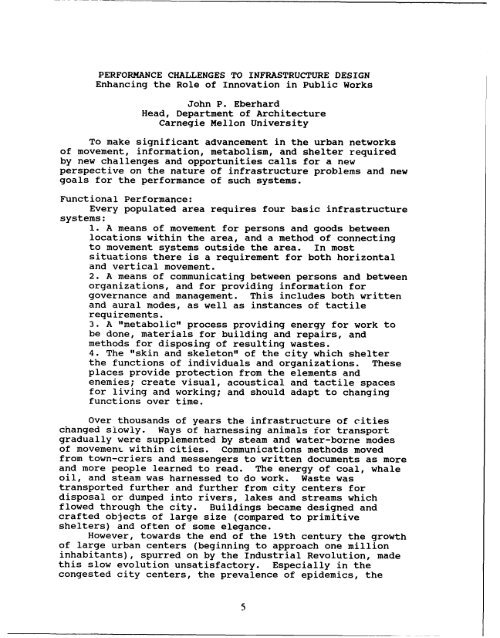Challenges and Opportunities for Innovation in the Public Works ...
Challenges and Opportunities for Innovation in the Public Works ...
Challenges and Opportunities for Innovation in the Public Works ...
Create successful ePaper yourself
Turn your PDF publications into a flip-book with our unique Google optimized e-Paper software.
PERFORMANCE CHALLENGES TO INFRASTRUCTURE DESIGN<br />
Enhanc<strong>in</strong>g <strong>the</strong> Role of <strong>Innovation</strong> <strong>in</strong> <strong>Public</strong> <strong>Works</strong><br />
John P. Eberhard<br />
Head, Department of Architecture<br />
Carnegie Mellon University<br />
To make significant advancement <strong>in</strong> <strong>the</strong> urban networks<br />
of movement, <strong>in</strong><strong>for</strong>mation, metabolism, <strong>and</strong> shelter required<br />
by new challenges <strong>and</strong> opportunities calls <strong>for</strong> a new<br />
perspective on <strong>the</strong> nature of <strong>in</strong>frastructure problems <strong>and</strong> new<br />
goals <strong>for</strong> <strong>the</strong> per<strong>for</strong>mance of such systems.<br />
Functional Per<strong>for</strong>mance:<br />
Every populated area requires four basic <strong>in</strong>frastructure<br />
systems:<br />
1. A means of movement <strong>for</strong> persons <strong>and</strong> goods between<br />
locations with<strong>in</strong> <strong>the</strong> area, <strong>and</strong> a method of connect<strong>in</strong>g<br />
to movement systems outside <strong>the</strong> area. In most<br />
situations <strong>the</strong>re is a requirement <strong>for</strong> both horizontal<br />
<strong>and</strong> vertical movement.<br />
2. A means of communicat<strong>in</strong>g between persons <strong>and</strong> between<br />
organizations, <strong>and</strong> <strong>for</strong> provid<strong>in</strong>g <strong>in</strong><strong>for</strong>mation <strong>for</strong><br />
governance <strong>and</strong> management. This <strong>in</strong>cludes both written<br />
<strong>and</strong> aural modes, as well as <strong>in</strong>stances of tactile<br />
requirements.<br />
3. A "metabolic" process provid<strong>in</strong>g energy <strong>for</strong> work to<br />
be done, materials <strong>for</strong> build<strong>in</strong>g <strong>and</strong> repairs, <strong>and</strong><br />
methods <strong>for</strong> dispos<strong>in</strong>g of result<strong>in</strong>g wastes.<br />
4. The "sk<strong>in</strong> <strong>and</strong> skeleton" of <strong>the</strong> city which shelter<br />
<strong>the</strong> functions of <strong>in</strong>dividuals <strong>and</strong> organizations. These<br />
places provide protection from <strong>the</strong> elements <strong>and</strong><br />
enemies; create visual, acoustical <strong>and</strong> tactile spaces<br />
<strong>for</strong> liv<strong>in</strong>g <strong>and</strong> work<strong>in</strong>g; <strong>and</strong> should adapt to chang<strong>in</strong>g<br />
functions over time.<br />
Over thous<strong>and</strong>s of years <strong>the</strong> <strong>in</strong>frastructure of cities<br />
changed slowly. Ways of harness<strong>in</strong>g animals <strong>for</strong> transport<br />
gradually were supplemented by steam <strong>and</strong> water-borne modes<br />
of movement with<strong>in</strong> cities. Communications methods moved<br />
from town-criers <strong>and</strong> messengers to written documents as more<br />
<strong>and</strong> more people learned to read. The energy of coal, whale<br />
oil, <strong>and</strong> steam was harnessed to do work. Waste was<br />
transported fur<strong>the</strong>r <strong>and</strong> fur<strong>the</strong>r from city centers <strong>for</strong><br />
disposal or dumped <strong>in</strong>to rivers, lakes <strong>and</strong> streams which<br />
flowed through <strong>the</strong> city. Build<strong>in</strong>gs became designed <strong>and</strong><br />
crafted objects of large size (compared to primitive<br />
shelters) <strong>and</strong> often of some elegance.<br />
However, towards <strong>the</strong> end of <strong>the</strong> 19th century <strong>the</strong> growth<br />
of large urban centers (beg<strong>in</strong>n<strong>in</strong>g to approach one million<br />
<strong>in</strong>habitants), spurred on by <strong>the</strong> Industrial Revolution, made<br />
this slow evolution unsatisfactory. Especially <strong>in</strong> <strong>the</strong><br />
congested city centers, <strong>the</strong> prevalence of epidemics, <strong>the</strong><br />
5







